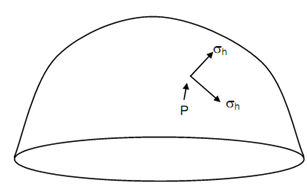Strains:
At any specific point in a thin spherical shell acted up by an internal pressure p, we have seen the stress working in all circumferential directions is the similar, owing to the symmetry of the shell. Its magnitude has been calculated as pd/4t . Letting three mutually perpendicular directions at any specific point on the shell, the stress shall be as follows.
Stress along with the two circumferential directions = pd /4t (tensile)
Stress along the radial direction = p (compressive)
These are the principal stresses at the point. However, when d/ t is extremely large to make the shell thin, hoop stress shall be very large compared to the internal pressure. Therefore, the compressive stress in the radial direction may be neglected leaving only the two principal tensile stresses of σh each.

Figure
With these principal stresses working at any point on the shell, we will now calculate the strain along the circumferential direction. Again, because of symmetry, it might be understood, that strains in all circumferential direction shall be the same. It shall be given as,
ε = σh / E - v σh/ E
where v refer to the Poisson's ratio for the material of shell, and E is refer to the Young's Modulus.
Hoop strain, εh = pd/4tE - v (pd/4t E)
εh = pd/ 4tE (1 - v)
This strain shall give the change in the circumference of the shell. As the circumference of a circular ring is directly proportional to its diameter, the diametrical strain (ratio of change in diameter to the original diameter) is the similar as the circumferential (ratio of the change in the circumference to the original circumference). Therefore, hoop strain shall be utilized to find the change in diameter of the shell.